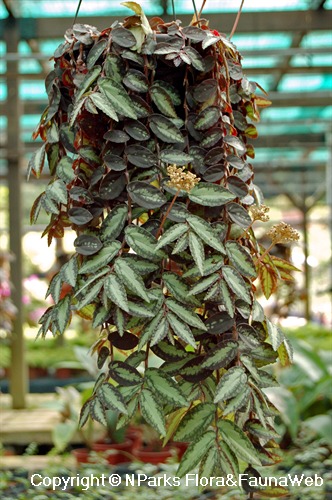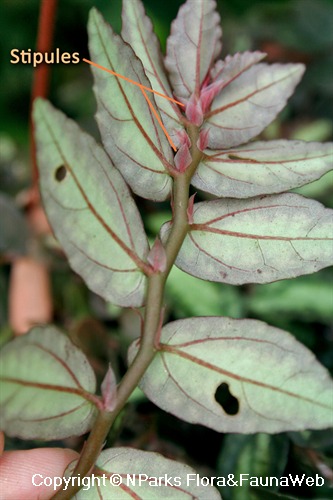.jpg)
Back
Procris repens (Lour.) B.J.Conn & J.T.Hadiah
| Family Name: | Urticaceae |
| Synonyms: | Polychroa repens Lour., Elatostema repens (Lour.) Hallier f., Pellionia repens (Lour.) Merr., Pellionia daveauana N.E.Br. |
| Common Name: | Trailing Watermelon Begonia, Wavy Watermelon Begonia, Satin Creeper, Rainbow Vine, Sisek Naga, 吐烟花 |
Name
Classifications and Characteristics
| Plant Division | Angiosperms (Flowering Seed Plants) (Dicotyledon) |
|---|---|
| Plant Growth Form | Herbaceous Plant, Creeper |
| Lifespan (in Singapore) | Perennial |
| Mode of Nutrition | Autotrophic |
| Plant Shape | Irregular |
| Maximum Height | 0.2 m |
| Maximum Plant Spread / Crown Width | 0.6 m |
Biogeography
| Native Distribution | Singapore, Peninsular Malaysia, Thailand, Philippines, Indonesia |
|---|---|
| Native Habitat | Terrestrial (Primary Rainforest) |
| Preferred Climate Zone | Tropical, Sub-Tropical / Monsoonal |
| Local Conservation Status | Native to Singapore (Presumed Nationally Extinct (NEx)) |
Description and Ethnobotany
| Growth Form | It is a small herbaceous creeper, with prostrate ground-hugging habit, up to 15 cm tall, spreading or trailing up to 60 cm. |
|---|---|
| Foliage | Its alternate, fleshy leaves have toothed or wavy leaf blades that are elliptic to oblong, and sometimes broadly egg-shaped, asymmetrically-cordate based, and 2.5–10 by 2–5 cm. The veins are mosaic-like on upper leaf surface, and distinctly reddish or brownish on lower surface. The stipules are pink-reddish, diamond-shaped, found at base of leaf petioles. Its leaf colour resembles watermelon rinds or the foliage of certain Begonias and are variable, ranging from grey-green in between brownish to purplish-green edges to almost totally brownish-green, and becoming completely purplish-brown with age. |
| Stems | Its semi-fleshy stems are slightly zigzag, brownish, rooting at nodes upon contact with ground. |
| Flowers | Its tiny flowers are white or pink with a tinge of silver, and arranged in branched clusters. The staminate (male) inflorescences are 0.6 -3.0 cm across, and 2-14 cm long, with the male flowers bearing 5 tepals (indistinguishable petals and sepals) and 5 stamens. The pistillate (female) inflorescences are smaller (3 mm across), stalkless, with the female flowers bearing 5 tepals (as long as or longer than fruits). |
| Fruit | Its fruits are tiny achenes, ovoid to ellipsoidal, tuberculate. |
| Habitat | It grows on moist shady spots on rocks and the forest floors. |
| Similar | It resembles Elatostema species, which have non-tuberculate, longitidinally-ribbed achenes, and whose female flowers have 3 tepals that are much shorter than the achenes. |
| Associated Fauna | It is the food plant for caterpillars of the butterflies, the great eggfly (Hypolimnas bolina bolina), Jacintha eggfly (Hypolimnas bolina jacintha), and danaid eggfly (Hypolimnas misippus misippus). |
| Cultivation | It prefers consistently moist but well-drained soils and is prone to rot under constantly waterlogged conditions. It requires high humidity, so it is best cultivated enclosed within terrariums if placed in air-conditioned or cold-draughty locations. It is easily propagated by stem cuttings. |
| Etymology | Specific epithet 'repens' means 'spreading' or 'creeping', a reference to the plant's growth habit. |
| Ethnobotanical Uses | Medicinal: Traditional Medicinal Uses In Malaysian traditional medicine, it is used to treat boils, inflammation, abdominal pain and rheumatism <2>. It is important to note that some therapeutic effects from traditional medicinal uses of plants are currently not supported or verified by scientific research. |
Landscaping Features
| Landscaping | It is grown for its attractive leaves. Under full shade, the leaves remain almost completely green but when given more light, the leaves become water melon-patterned. It is suitable for indoor as well as terrarium planting. |
|---|---|
| Desirable Plant Features | Ornamental Foliage |
| Landscape Uses | Container Planting, Suitable for Hanging Baskets, Interiorscape/ Indoor Plant, General, Vertical Greenery / Green Wall, Terrarium, Parks & Gardens, Small Gardens, Skyrise / Balcony |
| Thematic Landscaping | Naturalistic Garden |
Fauna, Pollination and Dispersal
| Fauna Pollination Dispersal Associated Fauna | Butterfly Host Plant (Associated with: Hypolimnas bolina bolina, Hypolimnas bolina jacintha, Hypolimnas misippus, Leaves) |
|---|---|
| Pollination Method(s) | Biotic (Fauna) |
| Seed or Spore Dispersal | Abiotic |
Plant Care and Propagation
| Light Preference | Semi-Shade, Full Shade |
|---|---|
| Water Preference | Moderate Water, Occasional Misting |
| Plant Growth Rate | Moderate |
| Rootzone Tolerance | Fertile Loamy Soils, Well-Drained Soils, Easy to Grow, Moist Soils |
| Maintenance Requirements | Moderate |
| Propagation Method | Seed, Stem Cutting (Herbaceous) |
Foliar
| Foliage Retention | Evergreen |
|---|---|
| Mature Foliage Colour(s) | Brown, Green, Red |
| Mature Foliage Texture(s) | Smooth, Papery |
| Prominent Young Flush Colour(s) | Brown, Red |
| Foliar Modification | Stipule |
| Foliar Type | Simple / Unifoliate |
| Foliar Arrangement Along Stem | Alternate |
| Foliar Attachment to Stem | Petiolate |
| Foliar Shape(s) | Non-Palm Foliage (Elliptical, Oblong, Asymmetrical) |
| Foliar Venation | Pinnate / Net |
| Foliar Margin | Crenate |
| Foliar Apex - Tip | Acute, Obtuse |
| Foliar Base | Cordate |
| Typical Foliar Area | Notophyll ( 20.25cm2 - 45 cm2 ) |
Non - Foliar and Storage
| Stem Type & Modification | Herbaceous |
|---|---|
| Root Type | Underground (Fibrous Root) |
Floral (Angiosperm)
| Flower & Plant Sexuality | Unisexual Flowers , Monoecious |
| Flower Colour(s) | Cream / Off-White, Pink |
|---|
| Flower Grouping | Cluster / Inflorescence |
| Flower Location | Axillary |
| Flower Size - Remarks | Staminate inflorescences 6-30mm across Pistillate inflorescences 3mm across |
| Inflorescence Type | Cyme |
| Ovule Placentation | Basal |
| Flowering Habit | Polycarpic |
Fruit, Seed and Spore
| Fruit Classification | Simple Fruit |
|---|---|
| Fruit Type | Indehiscent Dry Fruit , Achene |
References
| References | <1> Conn, B.J. & Hadiah, J.T. (2011). Precursor to flora account of Procris (Urticaceae) in Peninsular Malaysia. Gardens’ Bulletin Singapore 63(1&2): 155–162. <2> Mohan, S.S., Baboo, C. & Sirajudheen (2024). Physicochemical characterization, phytochemical analysis and in vitro biological investigations of Procris repens and Sargassum duplicatum. International Journal of Scientific Development and Research 9(9): 7–19. |
|---|
Image Repository
Others
| Master ID | 92 |
|---|---|
| Species ID | 1388 |
| Flora Disclaimer | The information in this website has been compiled from reliable sources, such as reference works on medicinal plants. It is not a substitute for medical advice or treatment and NParks does not purport to provide any medical advice. Readers should always consult his/her physician before using or consuming a plant for medicinal purposes. |


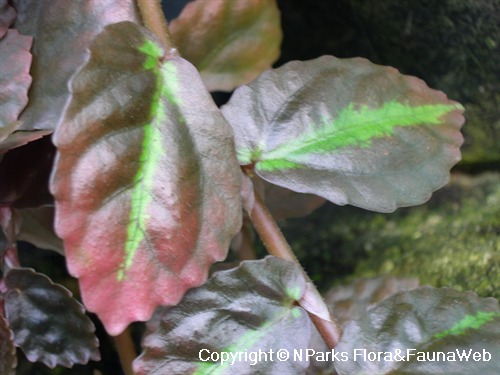
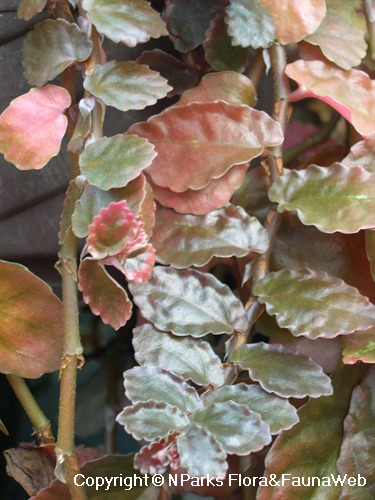
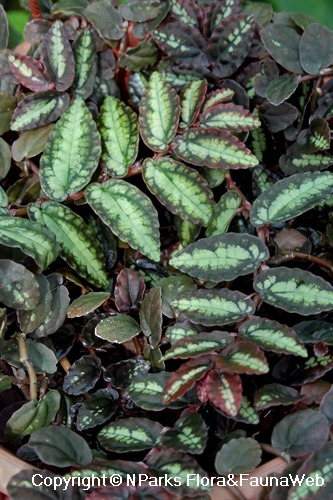


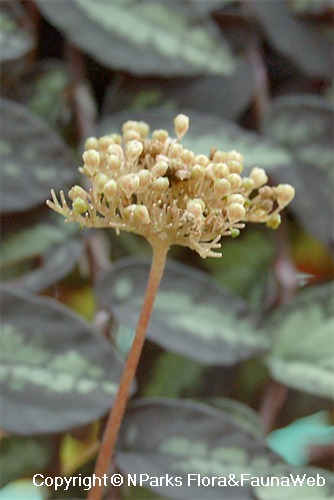

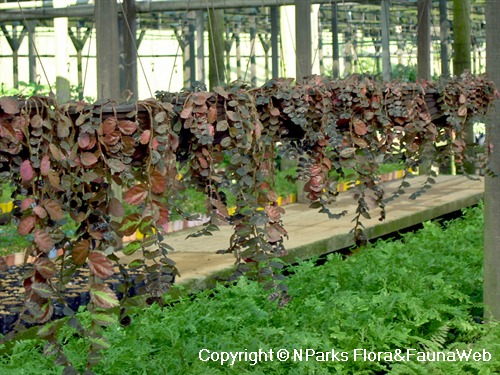
.jpg)
